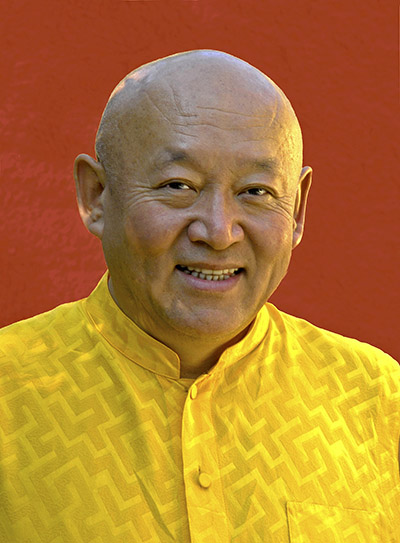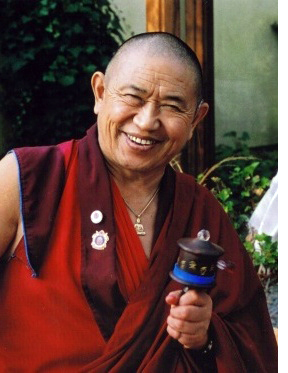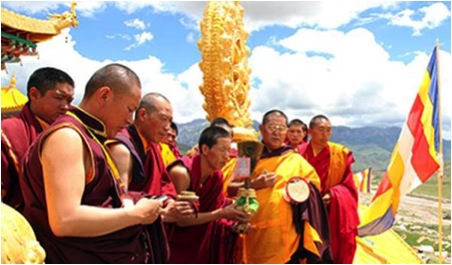Most Venerable Lho Ontul Rinpoche
Short Autobiography
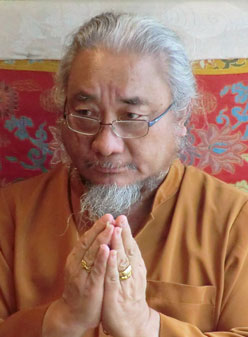 Rinpoche's previous incarnations are connected with Drigung Orgyen Nuden Dorje, a great discoverer of hidden teachings (terton) of the last century. He was well known as an emanation of Nyang Ban Tingdzin Sangpo, a great master at the time of the 8th-century Tibetan emperor Tri Song Deutsen.
Rinpoche's previous incarnations are connected with Drigung Orgyen Nuden Dorje, a great discoverer of hidden teachings (terton) of the last century. He was well known as an emanation of Nyang Ban Tingdzin Sangpo, a great master at the time of the 8th-century Tibetan emperor Tri Song Deutsen.
The elder brother of Nuden Dorje and first Ontül was Kunzang Drodul. He was born into a noble family lineage in the village of Zalmo Gang in Kharn province of Eastern Tibet.
The 5th Drigung Kyabgon Chetsang Rinpoche Thugje Nyima (1828- 1889) recognized him to be the emanation of Drog Ban Khiu Chung Lotsawa, one of the twenty-five main disciples of Guru Padmasambhava. Since Kunzang Drodul was the elder brother of Orgyan Nuden Dorje, his successive incarnations are known as Ontül, which means "the incarnation of the elder brother".
The present Ontül was born in Kham Nangchen in Eastern Tibet in the year 1950.
In 1954, His Holiness The 7th Drigung Kyabgon Chetsang Rinpoche and His Holiness the Gyalwa Karmapa Ranjung Rigpe Dorje recognized Ontül Rinpoche as the incarnation of Ontül, and was given the name Konchog Tenzin Thrinle Rabgye Palzangpo. Accordingly, in the same year Ontül Rinpoche was enthroned in the Monastery Dong Med Ogmin Thubten Shedrub Ling. Lama Kalsang Namgyal, the attendant of his previous incarnation, took the responsibility for giving him basic education such as in reading and writing, reciting texts, etc.
In 1959 when the Chinese Communist army occupied Tibet, his tutor Kalsang Namgyal and Ontül Rinpoche left their home monastery and, together with many monks and people of their village, they began their flight from Tibet to India. On the way they experienced terrible thirst and hunger, and were constantly threatened by the Chinese soldiers. In spite of many difficulties, they managed to cross the Tibetan border and arrived in India through Nepal. Life in India was also not easy because we did not have a place of their own to settle down. They were forced to wander from place to place for almost fourteen years.
In India, again Ontül Rinpoche met with Drigung Khandro Neni Rinpoche (mkhn' 'gro or dakini signifies a highly realized female yogi). She introduced Ontül Rinpoche to Ven. Khenpo Thubten, a great Nyingmapa teacher. The first teaching which Ontül Rinpoche received from the Khenpo was an extensive instruction on the Longchen Nyingthig Ngöndro practice. Later Ontül Rinpochereceived teachings from Khenpo Thubten on several other important texts.
On different occasions Ontül Rinpoche received Mahamudra and Dzogchen teachings from H.H. Dudjom Rinpoche, Khunu Lama Tenzin Gyaltsen, H.H. Dilgo Khyentse Rinpoche, 3rd Kalu Rinpoche and others.
From the Yogi Khyunga Rinpoche, Ontül Rinpoche received teachings and his personal instructions on the fivefold profound path of Mahamudra. In the years which followed, Ontül Rinpoche went to Ladakh where he received most of the important empowerments, instructions and oral transmissions of the Drigung Kagyu tradition from H.E. Chöje Togden Rinpoche. Ontül Rinpoche spent several years in Ladakh and travelled with Togden Rinpoche extensively in Ladakh to visit several Drigung monasteries with him.
After coming back to India, in 1971 Ontül Rinpoche bought a piece of land at Tso Pema (Rewalsar, H.P.) from the donations which I received from the people of Ladakh. With the help of resident monks Ontül Rinpoche managed to construct a monastery on this piece of land. Tso Pema means the "Lotus Lake", and this is one of the sacred places where Guru Padmasambhava demonstrated his miraculous powers.
The purpose of his exhibiting miracles on that place was to subdue the king and the people of that region, which was then known as Sahor. It took many years for me to complete the monastery with the sacred objects, ritual instruments, and other necessary things. Now the monastery is almost complete and nearly thirty monks are residing there, maintaining the tradition of the Drigung Kagyu.
In 1983 Ontül Rinpoche made a journey to central Tibet and Kham, his first visit to Tibet after escaping in 1959. First stopping in Lhasa and then after making a short visit to Drigung Til, Ontül Rinpoche traveled to his main monastery in Eastern Tibet. It was one of the bigger Drigung monasteries in that area and it is located close to his birth place.
During the Cultural Revolution the main monastery was completely destroyed. Through the effort of three Tulkus (Tulku Thupnying, Gyaltsep Tulku, Tulku Phuntsog), and Lopon Gonjam, monks, and the local people it is being rebuilt now, some parts have already been completed. There are about one hundred monks, some of them are in retreat of "Chagchen Ngaden". Since Yogi Pachung Rinpoche passed away, they are guided by his main disciple, Ven. Gelong Tenzin Nyima.
In this area Ontül Rinpoche spent almost six months attending several ceremonies in my monasetery, giving empowerments and teachings to the monks and local people. Ontül Rinpoche also initiated "Vajrakilaya Düpa" (annual ritual) in our monastery and since then it is done for ten days annually. The Monastery has several branch monasteries, among them is Bumang Monastery. Their Preceptors passed away during the Cultural Revolution. The new reincarnation, now eleven years old, was recognized by H.H. Drigung Kyabgon Chetsang Rinpoche and at present is studying in Drigung Kagyu Institute, Dehradun, U.P., India. Ontül Rinpoche's main monastery also has one branch nunnery which was destroyed completely by the Chinese communists. Since 1993 it is under reconstruction and some nuns are practising Dharma there.
From Kham, Ontül Rinpoche returned to Drigung in Central Tibet in the autumn of the same year. At Drigung Til monastery he had the opportunity to meet Yogi Pachung Rinpoche. From him Ontül Rinpoche received oral transmissions and teachings, which he, together with Ven. Gelong Tenzin Nyima, repeated thoroughly and then practised.
During this time Ontül Rinpoche met H.H. Drigung Kyabgon Chungtsang Rinpoche who was residing at Lhasa.
After staying in Drigung for a period of nearly three weeks, Ontül Rinpoche came back to our monastery at Tso Pema in Northern India.
Lho Ontul Rinpoche`s Activities
Ven. Lho Ontul Rinpoche holds the traditions of the Drikung Kagyu and Nyingma- Lineage. In order to uphold these traditions, he built the Monastery Ogmin Thubten Shedrub Ling in Rewalsar (H.P.), which is called by Tibetans also Tso Pema (Lotus Lake).
Following the request of H.H:Drikung Kyabgon Chetsang and his own wish, he came to Europe for the first time in 1988 in order to teach the Dharma. Since that time he is visiting regularly many centers in different parts of Europe, America, Asia and Australia. He has founded the Drikung Dzogchen Community (DDC), and at present there are 3 communities in Asia, Europe and North America. According to the request of his disciples, he has set up a 10-years Dzogchen- Course in the Yangzab tradition, which started already in 2002. He is also the founder of the Drikung Dzogchen Translation Project (DDTP), which is currently translating the Yangzab treasure teachings of the Drikung Kagyu Lineage, a terma text of Guru Padmasambhava, discovered by the great Drikung Tertön Gyalwang Rinchen Phuntsog (1509 – 1557).
In the holy year of Padmasambhava, the Monkey Year 2004, his elder son Karma Ratna was enthroned by H.H. Drikung Kyabgon Chetsang, in Lumbini, the birthplace of Buddha Shakyamuni, as quality emanation of the 4th Drikung Orgyen Nuden Dorje (1835-1902); and in 2005 he was officially installed as Lho Orgyen Drodul Dorje Rinpoche in the monastery of Tso Pema.



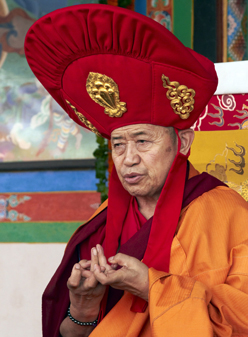 Garchen Rinpoche was born in 1936 in Nangchen Kham, Eastern Tibet. He was recognized and enthroned in by the former Drikung Kyabgon Shiwe Lodro. Garchen Rinpoche is considered one of the most important masters of the Drikung Kagyu tradition. His lineage of incarnations can be traced back to Gardampa Chodingpa, a heart-disciple of Kyobpa Jigten Sumgon, the founder of the Drikung Kagyu lineage of Tibetan Buddhism. In ancient India, he had been incarnated as Mahasiddha Aryadeva, the lotus-born disciple of the great Nagarjuna. In the seventh century, he was known as Lonpo Gar, the minister of the Tibetan Dharma King Songsten Gampo.
Garchen Rinpoche was born in 1936 in Nangchen Kham, Eastern Tibet. He was recognized and enthroned in by the former Drikung Kyabgon Shiwe Lodro. Garchen Rinpoche is considered one of the most important masters of the Drikung Kagyu tradition. His lineage of incarnations can be traced back to Gardampa Chodingpa, a heart-disciple of Kyobpa Jigten Sumgon, the founder of the Drikung Kagyu lineage of Tibetan Buddhism. In ancient India, he had been incarnated as Mahasiddha Aryadeva, the lotus-born disciple of the great Nagarjuna. In the seventh century, he was known as Lonpo Gar, the minister of the Tibetan Dharma King Songsten Gampo.